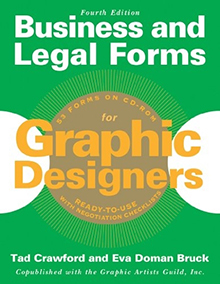GCIP 191: Contracts for Graphic Designers
The knowledge and use of good business practices are essential for the success of any professional or company, including the graphic designer and web developer. Graphic designers, whether employed by businesses or freelance, need to understand contract terms, negotiation, conditions, and the statutory and case law uniquely applicable to graphic design. Understanding the terms of a contract is essential to protecting the rights to use of work product and obtaining compensation.
The purpose of this class is, in part, to provide information, systems, and contracts that are useful to the organization and smooth functioning of the business side of graphic design and web development.
Sources of Contract Law

The term contract probably does not have a universally accepted definition. Generally, though, when we refer to a contract, we mean the total legal obligation that results from agreement between parties and established both duties and rights for those parties. Contract is a conclusory term. It means that a legally sufficient agreement has been reached and that neither party can back out without suffering legal consequences. Each party is under obligation to perform the duties stated in the contract.
Although modern American contract law draws elements from many cultures, its roots are found primarily in the common law of England, or English common law, which is the body of rules developed in England from ancient times until the American Revolution. These rules originally existed both in unwritten practices and beliefs and in the written opinion of judges. Among other things, the common law included rules for making contracts. Over time the American colonies adopted the common law, including its contract rules, into their own law. After the Revolution, all areas of American law, including contract law, separated from English common law and gradually become less English and more American. Nevertheless, even today fundamental similarities still exist between the law of England and the law of the United States.
In the early years of European settlement in North America, many other legal systems competed with the English common law. French settlers in North America brought with them their version of contract law, which was based on the civil law of the Napoleonic Code. This version of the law is still alive and well in the state of Louisiana. Spanish and Mexican settlers had their own version of the same law. The community property laws of several states, including California and Texas, still follow Spanish civil law. These laws give married women a legal share in all income and property acquired during marriage.
Furthermore, before the Europeans arrived, many Native American cultures already had established legal systems. For example, the Cherokee Nation had a complex legal system with well-developed rules covering such diverse legal issues as ownership of property, conduct of war, the institution of marriage, and international relations. Nevertheless, for historical reasons, English common law had the strongest influence on the early development of American contract law.
Today, when we refer to the common law of contracts, we mean the American law of contracts as it developed historically from English and American law before the Revolution. The term is also used, however, to draw a distinction between law originally formed in the written opinions of judges and statutes passed by a legislative body. This distinction can be somewhat confusing because in most states, much of the original common law has now been codified into state statutes. Thus, saying a contract is governed by common law sometimes means it is governed by those principles that first existed in common law.
Gregory Kelley, MA
Palomar College, Adjunct Faculty
Graphic Communications Department

